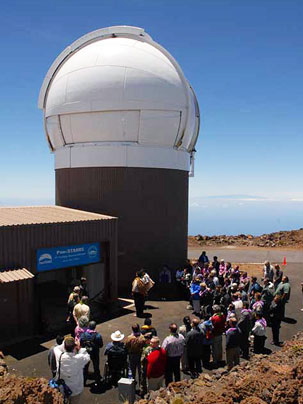[/caption]
A prototype telescope with an enhanced ability to find moving objects will soon be operational, and its mission will be to detect asteroids and comets that could someday pose a threat to Earth. The system is called Pan-STARRS (for Panoramic Survey Telescope and Rapid Response System) located on Haleakala mountain in Maui,Hawaii, and is the first of four telescopes that will be housed together in one dome. Pan-STARRS will feature the world’s largest and most advanced digital camera, providing more than a fivefold improvement in the ability to detect Near Earth Asteroids and comets. “This is a truly giant instrument,” said University of Hawaii astronomer John Tonry, who led the team developing the new 1.4-gigapixel camera. “We get an image that is 38,000 by 38,000 pixels in size, or about 200 times larger than you get in a high-end consumer digital camera.” The Pan-STARRS camera will cover an area of sky six times the width of the full moon and it can detect stars 10 million times fainter than those visible to the naked eye.
The Lincoln Laboratory at the Massachusetts Institute of Technology (MIT) developed charge-coupled device (CCD) technology is a key enabling technology for the telescope’s camera. In the mid-1990s, Lincoln Laboratory researchers developed the orthogonal-transfer charge-coupled device (OTCCD), a CCD that can shift its pixels to cancel the effects of random image motion. Many consumer digital cameras use a moving lens or chip mount to provide camera-motion compensation and thus reduce blur, but the OTCCD does this electronically at the pixel level and at much higher speeds.
The challenge presented by the Pan-STARRS camera is its exceptionally wide field of view. For wide fields of view, jitter in the stars begins to vary across the image, and an OTCCD with its single shift pattern for all the pixels begins to lose its effectiveness. The solution for Pan-STARRS, proposed by Tonry and developed in collaboration with Lincoln Laboratory, was to make an array of 60 small, separate OTCCDs on a single silicon chip. This architecture enabled independent shifts optimized for tracking the varied image motion across a wide scene.
“Not only was Lincoln the only place where the OTCCD had been demonstrated, but the added features that Pan-STARRS needed made the design much more complicated,” said Burke, who has been working on the Pan-STARRS project. “It is fair to say that Lincoln was, and is, uniquely equipped in chip design, wafer processing, packaging, and testing to deliver such technology.”
The primary mission of Pan-STARRS is to detect Earth-approaching asteroids and comets that could be dangerous to the planet. When the system becomes fully operational, the entire sky visible from Hawaii (about three-quarters of the total sky) will be photographed at least once a week, and all images will be entered into powerful computers at the Maui High Performance Computer Center. Scientists at the center will analyze the images for changes that could reveal a previously unknown asteroid. They will also combine data from several images to calculate the orbits of asteroids, looking for indications that an asteroid may be on a collision course with Earth.
Pan-STARRS will also be used to catalog 99 percent of stars in the northern hemisphere that have ever been observed by visible light, including stars from nearby galaxies. In addition, the Pan-STARRS survey of the whole sky will present astronomers with the opportunity to discover, and monitor, planets around other stars, as well as rare explosive objects in other galaxies.
Click here for more information about Pan-STARRS.
Source: MIT


This will be an awesome tool for transient astronomy, and LSST will be even more so.
I just hope the computing power and especially storage capacity will exist to allow the inspection of images even after a long time has passed…
This is nice, but what do we plan to do if we find something moving in our direction? There are as of yet no plans on the table for defending ourselves from asteroid impact.
So according to Moore’s Law, we will have cameras that powerful in our cell phones in 15 years. (If cell phones in their current form still exist at that time.)
RetardedFishFrog Says:
“So according to Moore’s Law, we will have cameras that powerful in our cell phones in 15 years. (If cell phones in their current form still exist at that time.)”
The chip (currently 40 cm square), that’s possible, perhaps…. but what about the lens? Currently, more pixels in a cell phone camera doesn’t make sense any more. Impressive megapixel figures for cell phones are only a point for advertising, really. Phone lenses aren’t up to it.
Thanks, Nancy. There are many of us out here that rely on you to keep up with such things. What a great perspective (example) on where we are with this technology.
I must say that I’m far more excited about the possibilities for detection of transient events than I am about the asteroid work. Should be a great tool for it, until LSST comes along and blows everything else away with its spectacular etendue!
This sounds like a project that people could comtribute spare cpu’s for – farmed out like seti@home…looking for the rocks@earth perhaps.